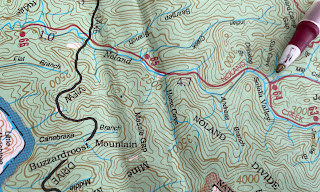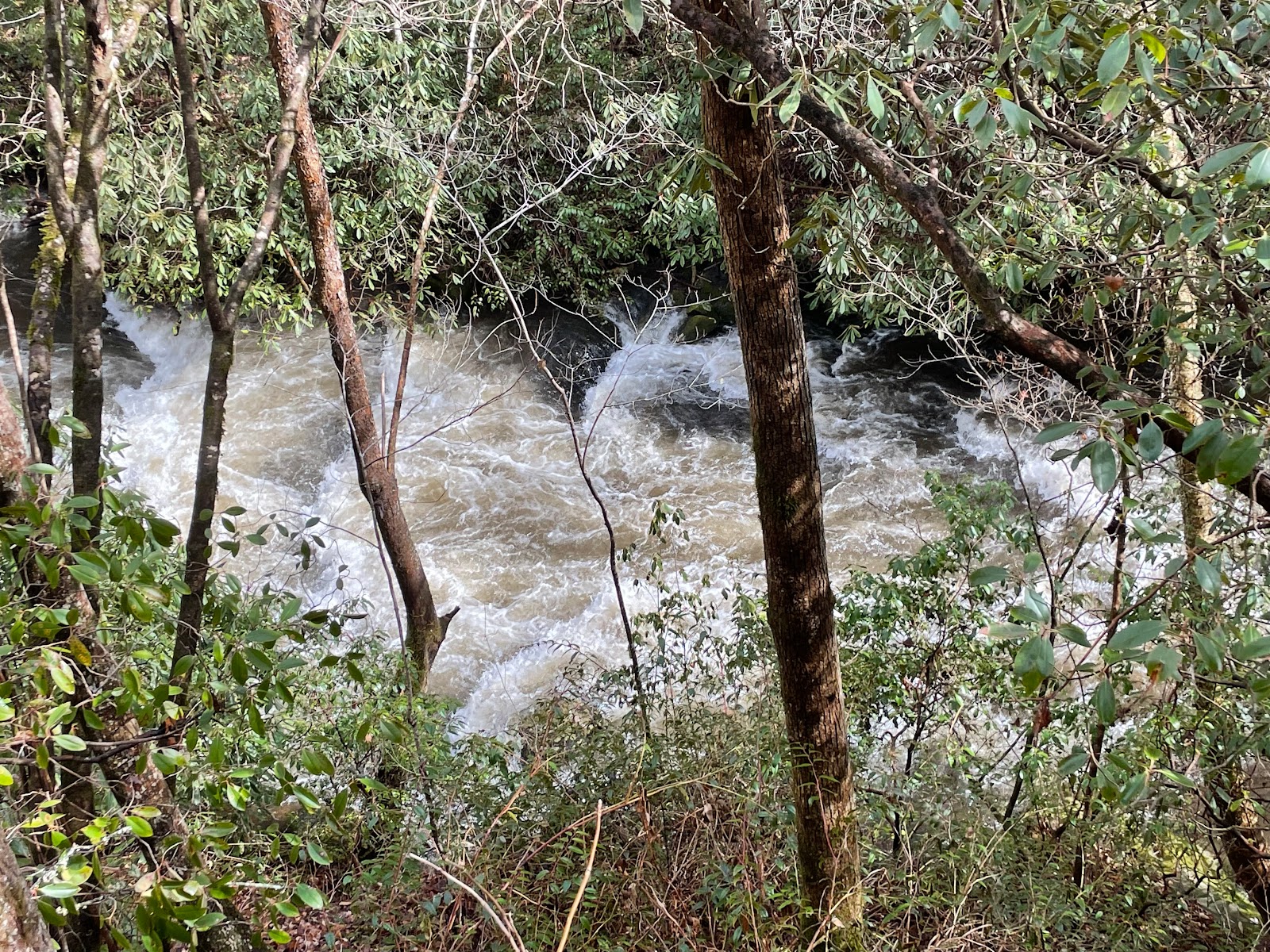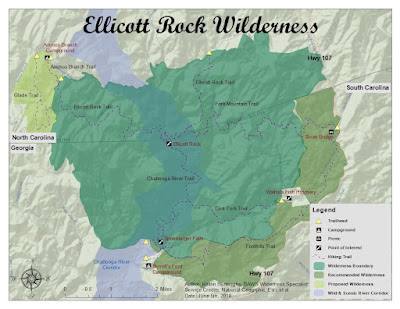This Noland Creek Trail hike, scheduled for January 25, gradually climbs some 300 feet of elevation over 4.2 miles, to the planned lunch-site at the 3 picnic tables of campsite 64. This is a wide, easy-walking flat dirt/gravel roadbed still used by park ranger vehicles. As it was still raining heavily in the morning, those that made it did not depart until 10:45am. The rain event was good for about 1.25", which produced a very angry looking brown-watered overflowing creek as we started our hike.


A half-mile before the gate that marks the end of the Road to Nowhere. and just before the sweeping curve of a bridge, is a parking lot on the left. Watch for the trail sign from which a path from the parking lot leads down and under the bridge to the main trail. This hike runs upstream to campsite 64, but following the trail downstream crosses some interesting bridges. It's a mile downstream to campsite 66 and then a bit further to end at a deep inlet where Noland Creek spills into the upper end backwater of Fontana Lake.
In spite of that very recent rainfall, a pleasant surprise was an amazing well drained roadbed for much of the journey. For a short period of time, the sun actually broke through.
It may still be January, but some frog movement alerted us to signs of spring. These critters seemed very knowledgeable about water depth. There were many pools along the side of the road where truck tires had left ruts, but unless they were at least 10 inches deep there were no egg masses of developing tadpoles. I wonder how the silt impacts their growth.
Multiple log jams along the river were backing up the heavy flow. I looked hard for signs of beavered logs. Alas, this dam was formed unaided by the buck-tooth crowd.
Just one sighting of last year's bear corn above the hard winter ground.
Christmas ferns (Polystichum acrostichoides) were common along the banks to the exclusion of any other fern except for rare sightings of fancy fern/intermediate wood fern. Beyond these and rhododendrons, sightings of other native plants were very rare.
A featherbell or sedge? Waiting for iNaturalist identification.
Putty root (Adam & Eve orchid) leaves are still feeding their roots for a couple more months until they disappear and shoot up their blossom stalks.
Little Brown Jug (Hexastylis arifolia)
Video: click to play.
Thanks to hiking so soon after the heavy rain, the white splashes of the filled side streams made it easy to spot their path reaching far back into the woods.
Towards the end of our hike the stream was already showing that the water was clear again.
fir clubmoss
In last year's hike up this trail large piles of gravel were alongside it. It has since been well spread over large sections of the old road bed.
These are the remains of the walls and fallen chimney of Cole Hyatt home circa 1940's.
Jonquil and yucca-type plants and boxwood trees next to the trail are classic signs of prior human habitation in the park. The tale of Cole Hyatt's family and departure, along with great photo of the house with the family standing on the front porch, are lovingly discussed at the
Reflections of Olde Swain site, September 1, 2013.
The numerous beech trees along our walk hang on to their pale brown leaves, a decorative contrast against the trees of the winter forest.
fancy fern/intermediate wood fern
After hiking the 4 miles both ways, still only one barely shiny berry of the partridgeberry family came into view.
At first I thought some paint had been spilled. This is a piece of bark heavily colonized by the fungus Rock Whitewash (Phlyctis petraea)
We're actually really happy campers....

In the above photo it is hard to make out the outlines of the old rock walls that held the waterwheel of the Rust Electric Plant (REP) on Noland Creek. A closer shot more clearly shows the foundations that supported the wheel.
What really brings these walls to life is the story of Phillip Goodenow Rust and wife Eleanor Francis Dupont and their 4300 acre estate in this area. They fought to retain their land through Federal Courts all the way to the Supreme Court. The story along with a fine picture of the Electric Plant building can be found at
Reflections of Olde Swain site, September 1, 2013.
Rhodobryum moss
A boulder about shoulder high and protruding towards the road was covered with this glorious colony of rhodobryum.
Rattlesnake plantain orchid
Broadleaf toothwort
Moon lichens (not yet confirmed with iNaturalist)
These Trailing Arbutuses (Genus Epigaea) still have some time to go before their lovely pink or white blossoms appear. Arbutuses were used by native tribes for a number of medical needs.
Pipsissewa (striped wintergreen)
See you next time.
Bob




































Comments
Post a Comment